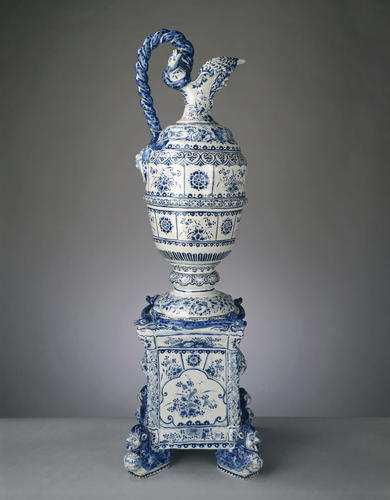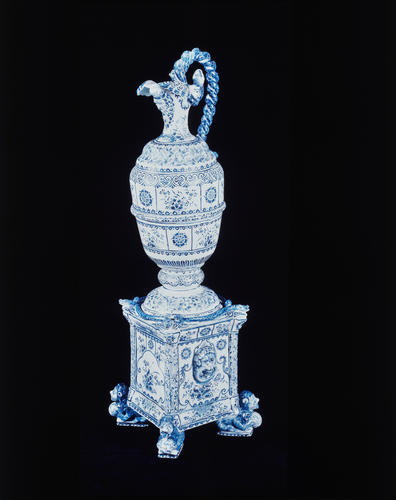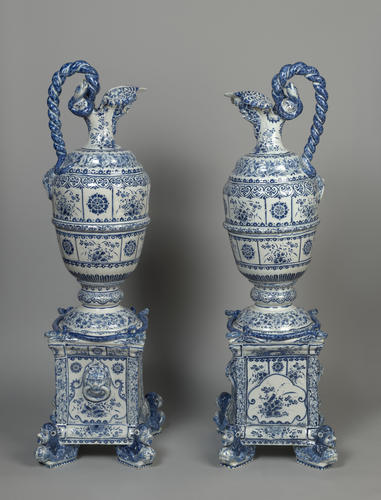Adriaen Kocks (d. 1701)
Pair of ewers and stands c.1694
Tin-glazed earthenware | 117.0 cm (whole object) | RCIN 1083
Queen's Gallery, Hampton Court Palace
-
The production of blue and white tin-glazed earthenware at Delft in the Netherlands in the mid-seventeenth century was stimulated in part by interruptions (caused by hostilities in China) in the supply of the oriental porcelain that had been imported in very large quantities by the Dutch East India Company since the beginning of the century. Although it is referred to in contemporary sources as Delffs porcelijn, the material produced at Delft is quite different, retaining the grey colour of the clay after firing at much lower temperatures than true porcelain. This material was then whitened with a thick glaze based on lead oxide with the important addition of tin, which produced the milky opacity required to imitate porcelain. Various factories were established, often in disused breweries whose names they retained, such as De Metalen Pot (the Metal Pot) or, in this instance, De Griexe A (the Greek 'A').
The 'Greek A' factory was founded in 1658 by Wouter van Eenhoorn, taken over by his son Samuel in 1678, and sold after the latter's death in 1686 to his brother-in-law, Adriaen Kocks (d. 1701), who was in charge when both the pieces were made. Queen Mary II (1662-94) was the factory's most important customer, ordering numerous vessels for her Dutch palaces of Honselaarsdijk and Het Loo, as well as for Hampton Court. A clear difference can be seen between the decoration of those pieces that were ordered for the Dutch and for the English palaces. The Dutch pieces, many of which date from the Samuel van Eenhoorn period, are generally painted with chinoiseries in imitation of their Chinese prototypes, whereas those supplied for Hampton Court have purely Western, stylised floral decoration between bands of loosely classical ornament. There are still ten large vessels (including the two pairs shown here) and three smaller pieces at Hampton Court, all of which were supplied directly to Queen Mary by Adriaen Kocks's factory. (A bill for £122 14s. 9d. for 'Dutch China ware' supplied by Kocks was paid after the Queen's death in 1694.) They were probably designed by William and Mary's court architect, Daniel Marot (1663-1752), who may have been inspired by seventeenth-century French silver for some of the shapes.
Many of Queen Mary's vases must have been ordered for the 'Delft-Ware Closett' adjoining the Water Gallery, a remodelling of a range of Tudor buildings overlooking the Thames at Hampton Court, which was probably intended as a retreat for the Queen's use during the rebuilding of the State Apartments. The gallery was demolished by William III in around 1700, when the vases were moved to the State Apartments.
Catalogue entry from Royal Treasures, A Golden Jubilee Celebration, London 2002Provenance
Commissioned by Queen Mary II prior to her death in 1694.
-
Creator(s)
(manufacturer)(ceramic manufacturer)(nationality)Acquirer(s)
-
Medium and techniques
Tin-glazed earthenware
Measurements
117.0 cm (whole object)
Category
Object type(s)
Place of Production
Delft [Netherlands]










